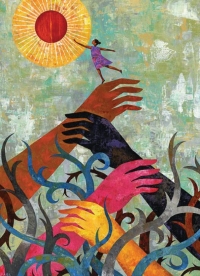Celebrating Women’s Equality Day
Celebrating Women’s Equality Day – August 26, 2015
By Sally Roesch Wagner
Does the modern American woman [who] is a petitioner before man, pleading for her political rights, ever stop to consider that the red woman that lived in New York state five hundred years ago, had far more political rights and enjoyed a much wider liberty than the twentieth century woman of civilization? I
This was Arthur C. Parker, a man of Seneca descent, writing in the Albany Press on April 11, 1909. Women had been demanding the right to vote in the United States for at least 61 years. It would be another 11 years before they forced the federal government to ensure that right with a constitutional amendment.
The early suffragists were well aware that Parker was right; Haudenosaunee (Iroquois) women, like most Native women, had a political voice. “The women were the great power among the clan, as everywhere else,” wrote Elizabeth Cady Stanton. “They did not hesitate, when occasion required, ‘to knock off the horns,’ as it was technically called, from the head of a chief and send him back to the ranks of the warriors. The original nomination of the chiefs also always rested with the women.” II
When Matilda Joslyn Gage was adopted into the wolf clan, Gage wrote that her adopted Mohawk sister told her that “this name would admit me to the Council of Matrons, where a vote would be taken, as to my having a voice in the Chieftainship.” How amazing this must have been to a woman who went to trial the same year for voting in a school board election. Considered for full decision-making in her adopted nation, she was arrested in her own nation for voting.
Political rights rested in a context of full equality, deep respect and solid integrity for women. Unlike the rape culture of the United States, violence against women and children in native communities was rare and when it occurred, dealt with harshly. A Haudenosaunee man could not be raised up as a chief if he had abused a woman.
Women had full authority over their own bodies and children were known through the female line. They controlled their own property and their own lives. For white women who had no right to their children, property or bodies as they were considered “dead in the law” and came completely under their husband’s authority once they married, knowing Native women was seeing what it was like to be free.
As we celebrate the hard-won victory of finally gaining a political voice in the United States on August 26, 1920, we may remember Arthur Parker’s words. It took over 72 years for women and their male allies to achieve women’s suffrage. Alice Paul first introduced the Equal Rights Amendment into Congress in 1923. The struggle to get equal rights for women protected by the Constitution has gone on for 92 years and we are still working to gain recognition of our equality that Haudenosaunee women had before Columbus.
I. Arthur C. Parker, "Woman's Rights in America Five Hundred Years Ago," Albany Press, 11 April 1909.
II. Elizabeth Cady Stanton, “The Matriarchate”, 1891.






